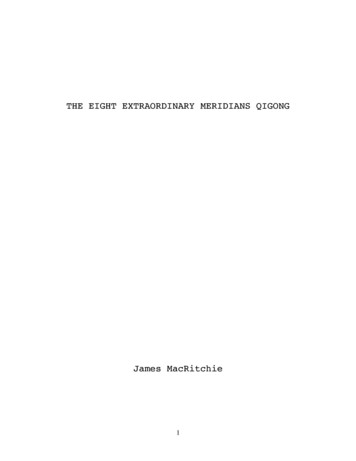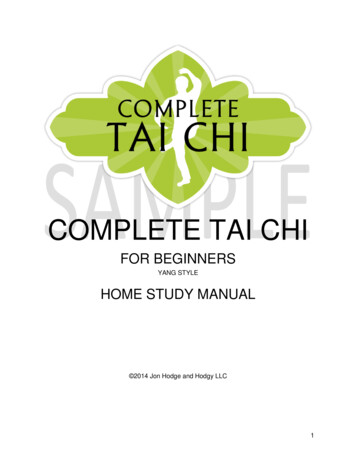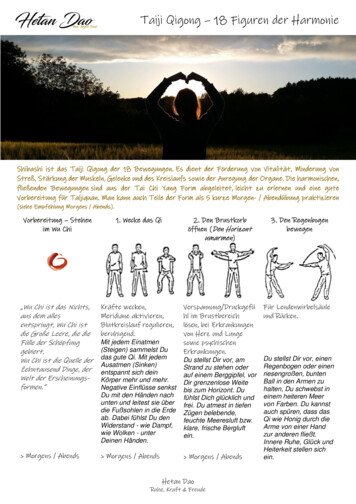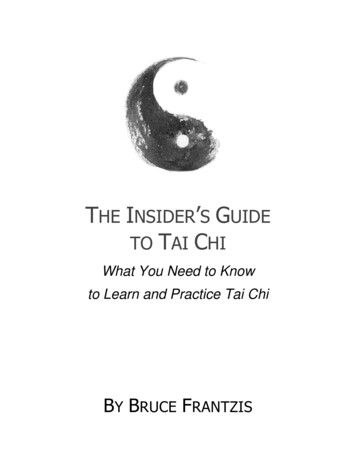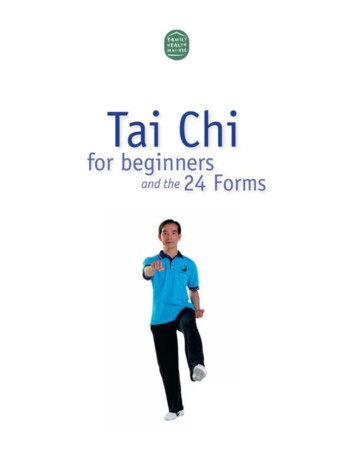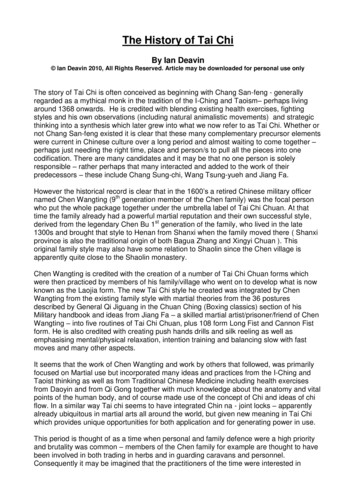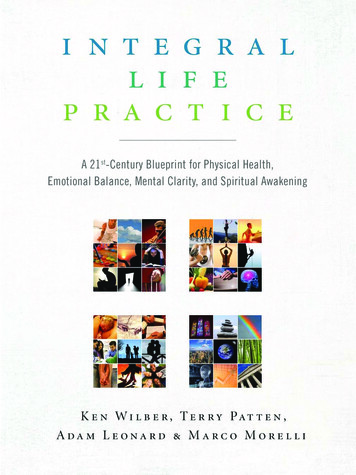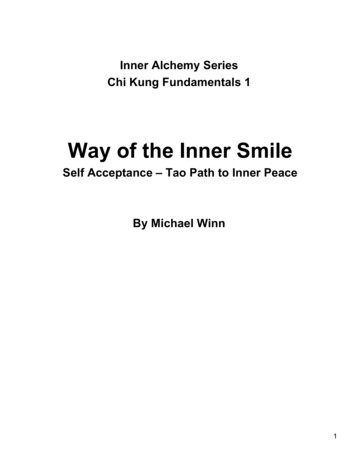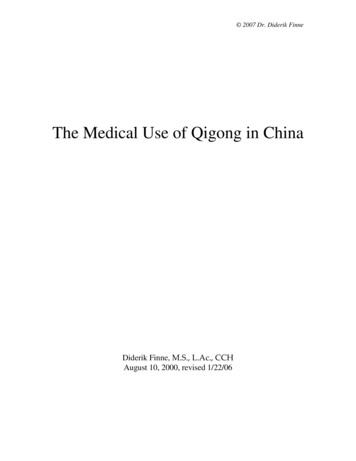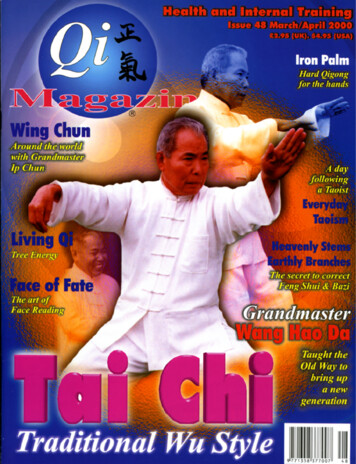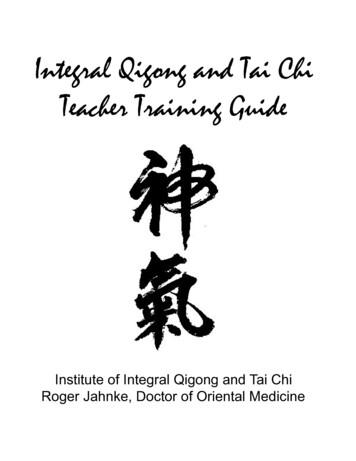
Transcription
Integral Qigong and Tai ChiTeacher Training GuideInstitute of Integral Qigong and Tai ChiRoger Jahnke, Doctor of Oriental Medicine
Table of ContentsWelcome to the Institute of Integral Qigong and Tai Chi Teacher Training5Acknowledgments6The Map of the Qigong and Tai Chi Universe7Integral Qigong and Tai Chi: Methodology and Forms19About Integral Qi CultivationFocus of Integral Qi Cultivation--The Qigong StateThe Characteristics of the Qi SensationKeys to Integral Qi CultivationThe Foundation of Integral Qi Cultivation -- The Three Intentful CorrectionsPrinciples of Integral Qigong and Tai ChiUniversal Principles of Qigong and Tai ChiIntegral Qigong Practice GuidelinesPrimordial Forces Generate Tai Chi [Illustration]Qi Matrix [Illustration]The Three Treasures and Integral QigongIntegral Qigong PracticesMind Affirmations for Ten Phase Integral QigongSong of the Ten Phases of Cultivation and Mastery of QiThree Levels of MindDaoist Medicine WheelQi Collection Meditation: Acknowledgment of the SourceMarrow WashingRapid Neurotransmitter Proliferation (RNP)Ten Minute Tune UpThe Integral Tai Chi MethodFull Integral Tai Chi Sequence and Suggested Tai Chi Easy SequenceThe Tai Chi Easy PracticesTai Chi ModificationsTai Chi Easy Movements -- Harmonizing Yin and YangTai Chi Easy Movements -- Brush Knee, Send QiTai Chi Easy Movements -- Cutting the Path to ClarityTai Chi Easy Movements -- Watching Clouds PassTai Chi Easy Movements -- Gathering Heaven and EarthTai Chi Sensing 8495152535455563
Table of ContentsIntegral Qigong and Tai Teacher ResourcesBell CurveThe Integral Qigong and Tai Chi Teacher’s SecretTeacher ProfilePresentation Feedback: A Model for Giving and Receiving FeedbackUsing the Baskets of Practice Methods for Tai Chi Easy What is Your Learning Style?Learning Styles and StrategiesLearning Styles and Making Your Learning Styles Work for YouWhat is Multiple Intelligence?Medical-Therapeutic Qigong and Tai ChiPhysiological Mechanisms Triggered by Qigong and Yoga/PranayamaYang Heaven, Yin Earth, and the Myriad of thingsBeneficial Acupressure PointsEFT Emotional Freedom TechniquesThe Complete EFT Emotional Freedom Techniques ProtocolTapping the PointsTapping Primordial QiQi (Chi) Channels -- Acupuncture MeridiansClock of Energy CirculationSix Healing SoundsHandling Medical Emergencies in Your 6107108Bibliography109About Roger Jahnke OMD, IIQTC Director1114
Welcome to the Institute of IntegralQigong and Tai Chi Teacher TrainingWelcome to an experience that will change the course of your life. The Institute of IntegralQigong and Tai Chi (IIQTC) was founded in 2000 in the spirit of the new millennium with itsprofound new possibilities. Intentful personal awareness will be required for conscious evolution. Qi (Chi) cultivation and the cultivation of power and virtue, through Qigong (Chi Kung)and Tai Chi (Taiji), are power tools for conscious personal improvement.Qigong, and later Tai Chi, were developed and refined carefully over thousands of years withthe exact purpose of mindful evolution of body, mind and spirit. Qigong and Tai Chi are majorplayers in the “new” health care system and in the popular movements of personal accountabilityand empowerment, mind/body medicine, living in the “now” and inner peace. Time magazinecalled Tai Chi “the perfect exercise”. Qigong is the mother of Tai Chi and all of TraditionalChinese Medicine.Certification for teaching self-care practices like Qigong, Tai Chi, Meditation, or Yoga will onlybecome more prevalent and less easy to complete as the holistic revolution merges with oursociety’s natural tendency for bureaucracy. Programs that seek to bring integrative, complementary, mind/body concepts to the mainstream typically require a system of certification forminimum standards of quality, effectiveness and safety. While this system does not currentlyexist at an official governmental level, it is a very reasonable career move to be ahead of thecertification curve. The IIQTC is vigilant in following trends.This training will both nurture and challenge you. You will make lifelong friends and be inspiredduring our time together. This event will be a profound opportunity to immerse yourself in healing, to actualize your personal mission of community service, and to launch your participationas a Qi cultivation professional in the “new” health care system. We will be fully focused onmaximizing body, mind and spirit in the Way of the ancient Qi masters who gave birth to Qicultivation in the sacred mountains of China.Be responsible for creating that experience for yourself. Nutritious food, simple lodging, fellow students devoted to deepening, lots of practice, rich information and the retreat contextall conspire to create a wonderful experience. Be careful about expectations. How often haveI seen people trying to get something they “expect” while missing the marvelous experiencethat is actually occurring.My sincerest gratitude and wishes for your success,Roger Jahnke OMD, DirectorInstitute of Integral Qigong and Tai Chi5
AcknowledgmentsThese words are dedicated to all Institute of Integral Qigong and Tai Chi students, teachers, staff andvolunteers who are creating a profound Qi field everywhere.It Will Not Fail UsThe reality that is present to us and in us:call it Being.Silence.And the simple fact that by being attentive,by learning to listen(or recovering the natural capacity to listen)we can find ourself engulfed in such happinessthat it cannot be explained:the happiness of being at one with everythingin that hidden ground of Lovefor which there can be no explanations.May we all grow in grace and peace,and not neglect the silence that is printedin the centre of our being.It will not fail us.--Thomas MertonSpecial Thanks to the Following for Graphic Arts, Illustration and CalligraphyDeborah Cushman, Jianye Jiang, Susan SpellmanContributing WritersMichael Clark, Rebecca McLean, Wayne Morris, Rhonda Richey, Dennis Rizzi, BonnieWeston6
The Mapof theQigong andTai ChiUniverselongevity7
The Map of the Qigong and Tai Chi UniverseBy Roger Jahnke OMDIn that state, the miraculous is at hand,the elixir is spontaneously produced and circulated,In that state the distance from here to the starsor to the depths of universe, is not,and the extent of our brilliantand profound uniqueness is less than vapor thin.In that state what could be discovered and knownis not somewhere else.Can you surrender to what is true?—Wu Wei, a student, with appearances here and there in historyMapping the Qigong and Tai Chi ConstellationsThe estimated 10,000 forms of Qigong (Chi Kung), including the numerous styles of Tai Chi Chuan(Taijiquan) captivate us with their names from nature– heaven, earth, and the five elements—fire, earth,wind, water, wood. Some focus on gathering Qi from trees, mountains, rivers and oceans. There areforms named after the legendary immortals and Chinese myths as in Yellow Emperor Qigong or LaoZi Qigong. Some are based on the insights of modern teachers. While others can be traced back to realpeople and actual lineages, the beginnings of Qigong are shrouded in the misty veil of prehistory toshamanic Master Yu’s Pace of the Dipper Stars.Many forms of Qigong, particularly medical Qigong, are very practical and named for their intent– Vitality Method, Muscle and Tendon Method, Back and Spine Enhancing Method, Cancer RecoveryMethod. Some Qigong forms are named for cosmic qualities. Many Qigong forms are named Primordial(Wuji) and describe that pristine, primordial state of the universe before the Big Bang, which causedYin/Yang to arise.Tai Chi, which translates as the Supreme Ultimate, is an exploration of the harmony and balance of theessential – Yin/Yang — forces of the boundless universe. There are hundreds of forms of Tai Chi alone–Yang style, Wu style, Chen style, Sun style, Guang Ping style, long form and short form. In addition,dozens of variations of Tai Chi Qigong, make the beauty and poetry of Tai Chi more accessible for useas a medical Qigong.Qigong can be done lying down, sitting, standing and walking. For the very ill or for those who wantto broaden their practice to include the moments just before sleep and just after awakening, Qigongcan be performed while lying down. This provides a way to do Qigong at times that are typically notdevoted to anything else. It also creates a way to extend your practice into directed dreaming as didthe famous Daoist Monk Chen Tuan at the Jade Spring Monastery near beautiful Flower Mountain incentral China.8
The heart of Qigong lies not in the form, but in the essence. The essence of Qigong is the Qigong statein which the Qi channels are open and circulating, inner resistance is at a minimum and the mechanismand spirit of your being are operating harmoniously. All the forms are maps to guide the practitioner intothis state. The immense diversity and sheer numbers of forms reflects the wide array of theoretical andphilosophical backgrounds along with the tastes and preferences of the people who developed them.Imagine that all of the Qigong methods are stars scattered throughout the heaven in what at first appears to be a random way. If you look again, over time the random stars appear to cluster together, andthe 10,000 forms arrange themselves into constellations. As always in finding and following a path, itis useful to have a map. Whether you practice with friends, begin in a class at your community center,align with a particular teacher who has advanced in Qi cultivation or travel to China to seek the originalmaster teachers, this information will help you to get your bearings and chart your path.The Kinds of QigongThe RootsThe TraditionThe BodyThe DynamicThe FormThe FocusLegendary or ancientHistoricContemporaryFitness, Longevity and PreventionMedicalDaoistBuddhistMartialLying Form specific, directed, formalizedNo Form spontaneous, formless, nonspecific, intuitiveInternal - NeigongExternal - Waigong9
The Historic Roots of Qigong Legendary or ancient Historic ContemporaryThe historic soil into which Qigong extends her roots is deep and rich. Her bountiful Daoist, Buddhist,fitness and longevity, medical and martial traditions arose from ancient legendary forms and methods,before writing and record keeping began. In The Pace of Yu, mentioned earlier, Shaman Yu developed awalking or dancing form to call the benevolent forces of Heaven to Earth by marking the designs of thecelestial realms, stars and planets on the ground. Shamanic interpretations of animals and the forces ofnature were common to all original cultures. In China, some of these evolved into early Qigong forms.One such form, the Flying Crane Form is very likely associated with shamanic origins and is reputedto have been a form of ritual called the Crane Dance.In the 4th Century BCE, Zhuang Zi, the famous student of Lao Zi, traces the cultivation practices fromhis own era to another legendary shaman from ancient time who, as the legend goes, lived to 800 yearsof age. “To pant, to puff, to hail, to spit out the old breath and draw in the new, practicing bear hangingsand bird stretchings, longevity the only concern. Such is the life favored by the scholar who practicesDao Yin, the man who nourishes his body with the hope of living as old as Pengzu.” Zhang Zi uses theearliest name for Qigong, Dao Yin, meaning to guide and direct Qi.The transition to historic forms of Qigong came with the earliest detailed writings that teach Dao Yin inthe Han Dynasty era, 206 BCE - 220 CE. The Dao Yin Jing, one of the original Qigong texts, was amongthe scrolls of the library of Master Ge Hong, a great Qi cultivation master from the 4th century CE. In1972, one of the most spectacular archeological finds in the historic era of Qigong occurred. In a groupof tombs from the Han Dynasty at Ma Wang Dui a silk scroll was discovered with forty detailed figuresin an array of Dao Yin postures. This is one of the first clearly inscribed historic forms of Qigong.Another of the first historic forms is known as Hua To’s Animal Play, a set of practices that express theQi of the tiger, deer, bear, monkey and crane. Hua To, a well-known and highly revered first centuryphysician of Chinese medicine, was famous for quite a few impressive innovations, including the useof hemp as an anesthetic and for being the “first” surgeon.It is typical for the more renowned of the historic forms, like the Animal Play of Hua To, to spin offnumerous versions over the following thousands of years. I have learned at least a dozen versions ofthe Animal Play in China and been exposed to a handful more in the United States. It is very nearlyimpossible to know whether the variation of a historic Qigong form that you may encounter is authentic. However, given the intent of all Qigong, it is likely that interpretations or modifications to historicpractices may contain significant improvements on the original. For example, when people ask about10
how to work with children using Qigong I almost always suggest modifying Hua To’s Animal Play to belight hearted and easy to learn. How long does it take a group of five-year-olds to “act like a tiger?”The Tendon Changing and the Marrow Washing forms that were originally created by Bodhidharma,are prime historic forms that have developed dozens of variations over many years — some gentle forhealing, others rigorous and demanding for the martial arts. When Buddhism came to China it was immediately embraced with enthusiasm. Many felt strongly that Buddha may have been a reincarnationof the great Daoist Immortal Lao Zi. Or that Lao Zi had been a primary teacher for Buddha. Buddhismwas thought by many to be the later teachings of Lao Zi after his ascension as an immortal. As the legendgoes, Lao Zi grew tired of the small mindedness of men and the empire, and he elected to disassociatewith popular culture in around 450 BC by departing to the west of Xian, into the Zhong Mountains(Zhong Shan). Bodhidharma (Da Mo to the Chinese), who helped import Buddhism to China, did arrivefrom those same mountains and his sage teachings were as deep as the wisdom of Lao Zi.When Bodhidharma came to the Shaolin Temple at Song Mountain, he taught the monks a number ofQigong forms including the Tendon Changing and the Marrow Washing Methods. Due the very ancienthistory of China and its sheer immensity, hundreds or even thousands of versions of these practicesexist today. These two methods have become a foundation in my own teaching. I have personallystudied dozens of versions of these forms in my own Qigong evolution. I actually teach both in a verysimple form that is very practical for all new students whether they are overcoming disease or buildingphysical strength for the martial arts. These forms evolve to a more esoteric form as students advanceand deepen their practice.Because Qigong is derived from our relationship with Qi and this relationship is constantly transforming due to social, scientific, political, spiritual and personal factors, Qigong is always changing. Everyera has its newly developed or contemporary forms of Qigong. During the Tang and Song dynasties,Qigong flourished and evolved rapidly and many new forms were developed. The period between 1970and the present was another such renaissance for Qigong. The Qigong explosion following the CulturalRevolution in China was so radical that Qigong historians have called it the Qigong Rush.Contemporary forms of Qigong can trace their origins back to the ancient legendary era. The FlyingCrane Form was first legendary, then historic and now a contemporary interpretation has evolved to suitcontemporary needs. Guo Lin’s Cancer Recovery Walking Qigong, developed in the 1970s, originatedin the teachings of her grandfather who probably learned from a historic or even legendary lineage.Universal Intelligence Qigong, attributed to Dr. Pang Ming, is an immensely popular contemporaryform with over eight million practitioners worldwide. Spontaneous Qigong is probably the most ancientQigong; it is formless and was probably first done by humans who could not even speak an organizedlanguage somewhere around 60,000 years ago.11
The Traditions of Qigong Fitness, Longevity and PreventionMedicalDaoistBuddhistMartialThe stories that can be told, particularly of the Daoist, Buddhist and Martial traditions are part of theeloquence and poetry of Qigong. Besides its beautiful connections to nature and the universe, we areamazed by the extraordinary stories of wandering Daoist monks, compassionate Buddhist Masters andthe fighters, who used Qi rather than muscle power to defend emperors, court ladies, ministers andeven, in certain eras, to topple unethical dynasties.Qigong for fitness, longevity and disease prevention is the ideal in modern China. The billions of peoplecould, if unhealthy, create a terrible health crisis. The national health system encourages people to sustaintheir health by using Qigong and Tai Chi. The quest for healthy longevity is traditional in China. In theWest, we now live longer, but there is doubt about the quality of life in people who are sustaining theirlives with drugs and at risk for side effects and drug interactions. Qigong also enhances performance andproductivity by addressing the health and function of those who are relatively well, including athletes,scholars and business people. Ultimately, Qigong helps to create healthy, happy and compassionatepeople. Traditionally, in China people of wisdom are fondly considered to be immortals.Medical Qigong is typically practiced by patients who work with physicians who prescribe specificQigong methods for specific medical conditions, consistent with the diagnosis of Qi deficiency or Qistagnation. A person with deficiency of kidney Yang leading to cold extremities and fatigue wouldbe prescribed a completely different practice than a person with stagnant liver Qi. However, generalQigong practices that are used in hospitals and clinics and any form of Qigong that is targeted at resolving medical challenges is considered by many to be medical Qigong. Medical Qigong also includes Qiemission healing or clinical treatment.Daoist Qigong is the most ancient Chinese framework for intentfully perceiving the multidimensionalnature of the world. The health or healing gained from one’s practice is a side effect of exploring one’srelationship with the essence of nature. Daoist Qigong operates on the premise that there is significantvalue in honoring and caring for body you have been given in this lifetime. Your grandmother’s ideathat the body is a temple is very consistent with Daoist Qigong.Buddhist Qigong merges the foundations of Buddhist philosophy and spirituality with Daoism. WhenBuddhism arrived in China, it was easily embraced because so much of its philosophy is consistentwith Daoist thought. However, there are some differences. Daoists do Qigong to honor the spirit bythe filling the vessel with vitality, attaining a clear and undisturbed mind and merging with The One.12
Buddhists tend to discount the body and even the mind as illusory distractions from ultimate reality,which is pure emptiness.Martial Qigong is the aspect of the martial arts associated with maximizing fighting (or sport) strengthto engage in any challenge, physical or mental empowered by the Qi. The great Daoist temples – WhiteCloud, Dragon-Tiger, Jade Spring as well as the great Buddhist temples – Soul’s Retreat, Shaolin, NineFlowers — were all called upon at many points in China’s tumultuous history, to produce monks withthe highest spiritual training and values. Because of the monks’ cultivation of the invisible forces ofHeaven and Earth, they had incredible fighting powers. This created the extraordinary Chinese traditionof Daoist and Buddhist monk warriors who, were also compassionate monk healers. The martial artistwith the greatest skill brings Qi cultivation to the conflict.The highest value in this context is conflict resolution, achieved with no violence. This innovation ofspiritual warriors from China is one of the great contributions of the Chinese Qi community to the world.The same Qi that makes the warrior mighty is the Qi of healing. The greatest victor is the martial expertwho solves the conflict without use of martial force. There were times when the conflict was resolvedby terrible violence. However this framework of bringing peace of mind and highest spiritual valuesto bear on disputes will have a positive effect on conflict resolution in contemporary time as the arts ofQi cultivation become more known outside of China.Body Component in QigongOne of the easiest ways to describe the kind of Qigong practice is to describe the body component. Amethod with Buddhist or Daoist origins may appear indistinguishable to all but the most informed eye.Yet the difference between a method performed lying down is very clearly different from a methoddone sitting or standing, or walking.Qigong Performed Lying DownWith breath focus and meditationWith self-applied massage or postural adjustmentsWith gentle movementSitting QigongWith meditationWith massageWith gentle movementStanding QigongMeditation in stillnessWith gentle movementWith self-applied massageWalking QigongWith gentle or dynamic movementWith breath focus and meditation13
Gentle movement while lying down means to move the hands, feet, fingers, and toes or to shift theposture while lying down. Just before falling sleep and just after awakening are perfect times to doQigong while lying down. It can also be easily adapted for those who are recovering from surgery orexperiencing severe illness, even those who are unable to get out of bed.Sitting Qigong is any meditation in the Chinese tradition, or from any other tradition, whether sittingin a chair or cross-legged. Unique to the Chinese tradition are sitting and moving forms. I first learnedsitting Qigong with movement from Chang Yi Hsiang of the Tai Hsuan College during my study ofChinese medicine. The Silken Sitting Form starts with two relatively simple forms called Bloomingof Spring and Lighting the Back Burning Spaces (associated with the Gate of Life. Then in one of themost beautiful forms I have ever seen, The Ascending Dragon, the practitioner goes from sitting tostanding.Standing Qigong is probably the most common form of Qigong. Universal Intelligence Qigong, alsoknown as ChiLel Qigong in the United States is a kind of standing Qigong. Other examples of standingQigong are Tendon Changing, Marrow Washing, Seven Precious Gestures, the Vitality Method, andDao Guang (Daoist Light) Qigong, to name a few. While most forms can be adapted for sitting thosewho are well usually do them standing. Standing builds strength and endurance.Walking Qigong is any form where the practitioner advances or steps back. Tai Chi is the most widelyknown walking form of Qigong. While Tai Chi is quite complex, the contemporary Guo Lin CancerRecovery Walking Qigong is one of the easiest forms of Qigong to grasp and use. This is excellentbecause people with cancer need powerful tools that are easy to use. Research has proven that themethod developed by Guo Lin is also very effective for many other disorders including diabetes. Oneof my favorite forms of walking Qigong is the Wild Goose (Dayan Gong). In it you “become” a wildgoose, the bird revered by the Chinese to fly the highest and which has the most direct experience oftouching Heaven and collecting the Qi of Heaven.Self administered massage, to both the muscle groups and pressure points along with patting and evengentle pounding, is frequently included in Qigong. Anything that enhances, refines and cultivates theQi is Qigong.The Dynamic, Form and Focus of QigongTwo subtle features to mapping the universe of Qigong are its dynamic form and focus. The dynamicof Qigong reveals the huge difference between absolute stillness, which is Yin and extreme movement,Yang. Specific and directed Qigong forms cultivate Qi in a completely different context than purelyspontaneous and formless methods. An almost separate universe of Qigong emerges in the context ofthe external focus of Qigong.14
The Dynamic of Qigong Quiescent Dynamic VigorousThe focus of Qigong is deep relaxation and a purposeful freeing of the nervous system and inner function from the effects of tension. When one elects to enter the Qigong state, during a Qigong practicesession or anytime throughout the day, posture and breath are important. However it is the state of clearminded relaxation that has the most power to pull you into the Qigong state. Most Qigong forms arerelatively Quiescent, allowing for the decrease of inner resistance and maximum flow.One can also attain the Qigong state in dynamic or vigorous practices. In fact Gongfu (kung fu), therenowned martial arts now called Wu Shu in China, has the intention of sustained Qi focus through clearmindedness during intense activity and conflict. There are cleansing or purifying methods that are morevigorous with the intention of expelling spent or extra Qi. While all forms of Qigong are meditations,the quiescent forms are the closest to what we usually associate with meditation. In reclining, sitting,and standing Qigong there can be absolute stillness or there can be movement. In quiescent Qigong– lying down, sitting or standing – there is only stillness.According to an ancient proverb, “The more you focus on movement outside, the less you can focuson movement inside.” When you place your attention on external movement, Qi and inner resourcesare busy attending to the function of the muscles and the metabolism of “doing”. When the mind isexternally focused the preferred state of inner directed, clear and neutral mind is less attainable.It is also stated, “Those who practice only quiescence become ill with diseases of stagnation.” Giventhe value of inner focus and calm in Qigong, it seems like a major contradiction that the quiescent statecauses stagnation of inner fluids (blood and lymph) and a stagnation of Qi, which can lead to disease.Rather than a contradiction, this is a revelation of Yin – Yang harmony and balance. It is best to havea Qigong practice that combines the quiescent methods with the dynamic methods.Martial arts usually include meditation practices. The meditation is Yin; the vigorous martial arts methods are Yang. The two together foster balance and harmony of the body, mind and spirit. Many formsof Qigong are mildly dynamic, that is neither completely quiescent nor wildly vigorous. Such formsinherently harmonize Yin and Yang within one method. All forms of Tai Chi are mildly dynamic andcarefully balanced — allowing mind clearing, meditation and relaxation to occur simultaneously withgentle movement. The most important aspect of Qigong is that it allows the healing and empoweringeffects of both meditation and gentle movement to act synergistically.15
The Form Form – specific, directed, formalizedNo form – spontaneous, formless, nonspecific, intuitiveQigong forms frequently have beautiful poetic and philosophical names that deepen their meaning.What other health promotion practice uses images like “Hands Pass Like Clouds” or “Immortal DragonCultivating Golden Elixir”? The inner practices can also have very poetic descriptions as in “MergingWater and Fire to Transcend the Matrix” or “Circulating the Light of the Inner Heaven”.Some Qigong forms are brief, simple, and easy to learn, practice, and teach. For example, in Flowing Motion, a classic used by millions of people in China, you simply start in a preliminary standingposture. On the inhalation, with arms at your side, you swing the arms forward and upward slowly onthe inhalation, until at about the level of your eyes. On the exhalation, you allow the arms to drift backdown, gently. You may repeat a few or many times. Simply doing one hundred repetitions of the Flowing Motion is noted in China as a way to “be healthy for the rest of your life”. In fact, it is said that ifyou do a thousand of the Flowing Method you will become immortal. Most people understand that, tothe Chinese, this means you will gain access to your universal and eternal self.Some Qigong forms such as Tai Chi (Taiji) are detailed and lengthy. Tai Chi (Taiji) is an elaborateQigong style with 108 movements done in the same order and in the same way every time. In Tai Chi,you become deeply involved in purposefully coordinating yourself with universal energies and principles — the Supreme Ultimate. Another detailed specific form is the Wild Goose Form (Dayan Gong),which has two sections of 64 movements. Most forms can be broken down into smaller componentsfor ease of learning and practice. The Tai Chi Long Form of 108 movements is often shortened 24, 28or 32 movements. The traditional 108 movements can be reduced even further to a subset of 10 to 13movements that are repeated, called Tai Chi Qigong.In Spontaneous or Formless Qigong, there is nothing to learn and nothing to follow. Natural Flow Qigongis formless Qigong. Quiescent Qigong meditation where there is no external movement is formless asthere is no external movements to learn and practice. Methods that include body movement, but are notdirected, specific and formalized are also formless. The very simple nature of formless Qigong makesit particularly accessible to people who feel uncoordinated or do not believe they have the time to graspQigong forms. The difference between a beginner and someone with lots of experience in formlessQigong is invisible. When I lead classes or practices in formless Qigong people always comment thatit was their favorite part. With the formless method you can work the Qi into the deepest places whereit is needed, the way water finds its way deep into the aquifer underground.Spontaneous Qigong is sometimes called Wuji Qigong or Dancing
Qigong and Tai Chi (IIQTC) was founded in 2000 in the spirit of the new millennium with its profound new possibilities. Intentful personal awareness will be required for conscious evolu-tion. Qi (Chi) cultivation and the cultivation of pow
